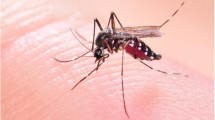Abstract
The leaf extract of Acalypha indica with different solvents viz, benzene, chloroform, ethyl acetate and methanol were tested for larvicidal, ovicidal activity and oviposition attractancy against Anopheles stephensi. The larval mortality was observed after 24 h exposure. The LC50 values are 19.25, 27.76, 23.26 and 15.03 ppm, respectively. Mean percent hatchability of the ovicidal activity was observed 120 h after treatment. The percent hatchability was inversely proportional to the concentration of extract and directly proportional to the eggs. The highest effective attractancy of 90.09%, 94.20%, 85.43% and 95.75% were observed at 100 ppm concentration viz, benzene, chloroform, ethyl acetate and methanol, respectively. The lowest effective attractancy of 47.17%, 61.94%, 49.28% and 68.12% were observed at 25 ppm concentration viz, benzene, chloroform, ethyl acetate and methanol, respectively. The results that the leaf extract of A. indica is promising as larvicidal and ovicidal activity and oviposition attractancy against malaria vector A. stephensi.
Similar content being viewed by others
References
Al-Sharook ZK, Balan Y, Jiang Y, Hein Z (1991) Insect growth inhibitors from two tropical Meliaceae. Effect of crude seed extracts on mosquito larvae. J Appl Entomol 111:425–430
Ansari MA, Vasudevan P, Tandon M, Razdan RK (2000) Larvicidal and mosquito repellent action of peppermint (Mentha piperita) oil. Biores Technol 71:267–271
Ascher KRS, Schmutterer H, Zebitz CPW, Naqvi SNH (1995) The Persian lilac or chinaberry tree: Melia azedarach L. In: Schmutterer H (ed) The Neem Tree: source of unique natural products for integrated pest management, medicine, industry and other purposes. VCH, Weinheim, pp 605–642
Burfield T, Reekie SL (2005) Mosquitoes, malaria and essential oils. Int J Aroma 15:30–41
Chopra RN, Nayar SL, Chopra IC (1956) Glossary of Indian medicinal plants. CSIR, New Delhi
Finney DJ (1971) Probit analysis. Cambridge University Press, London, p 38
Govindarajan M, Jebanesan A, Pushpanathan T (2008) Larvicidal and ovicidal activity of Cassia fistula Linn. Leaf extract against filarial and malarial vector mosquitoes. Parasitol Res 102:289–292
Jeyabalan D, Arul N, Thangamathi P (2003) Studies on effects of Pelargonium citrosa leaf extracts on malarial vector, Anopheles stephensi Liston. Biores Tech 89(2):185–189
Kalyanasundaram M, Dos PK (1985) Larvicidal and synergistic activity of plant extracts for mosquito control. Ind J Med Res 82:1–19
Kelm MA, Nair MG, Schutzki RA (1997) Mosquitocidal compounds from Magnolia salicifolia. In J Pharmacognosy 35:84–90
Kramer WL, Mulla S (1979) Oviposition attractants and repellents of mosquitoes:oviposition responses of Culex mosquitoes to organic infusions. Enviro Entomol 8:1111–1117
Kreutzweiser DP (1997) Non-target effects of neem-based insecticides on aquatic invertebrates. Ecotoxicol Environ Safety 36:109–117
Miura T, Schafer CH, Takahashi RM, Mulligan FS (1976) Effects of insect growth inhibitor, dimilin on hatching of mosquito eggs. J Econ Ent 69:655–658
Murugan K, Jeyabalan D (1999) Mosquitocidal effect of certain plants extracts on Anophels stephensi. Curr Sci 76:631–633
Muthukrishnan J, Puspalatha E (2001) Effects of plant extracts on fecundity and fertility of mosquitoes. J Appl Entomol 125:31–35
Peng Z, Beckett AN, Engler RJ, Hoffman DR, Ott NL, Simons FER (2004) Immune responses to mosquito saliva in 14 individuals with acute systemic allergic reactions to mosquito bites. J Allergy Clin Immunol 114:1189–1194
Pushpanathan T, Jebanesan A, Govindarajan M (2006) Larvicidal, ovicidal and repellent activities of Cymbopogan citrates stapf (Graminae) essential oil against the filarial mosquito Culex quinquefasciatus (Say) (Diptera:Culicidae). Trop Biomed 23:208–212
Rajkumar S, Jebanesan A (2002) Oviposition attractancy of Solanum aerianthum leaf extract for Culex quinquefasciatus. J Exp Zool India 5(2):221–224
Rajkumar S, Jebanesan A (2004) Mosquitocidal activities of octasane from Moschosma polystachyum Linn. (Lamiaceae). J Ethnopharm 90:87–89
Sivagnaname N, Amalraj D, Kalyanasundaram M, Das PK (2001) Oviposition attractancy of an infusion from a wood inhabiting fungus for vector mosquitoes. Indian J Med Res 114:18–29
Su T, Mulla MS (1998) Ovicidal activity of neem products (azadirachtin) against Culex tarsalis and Culex quinquefasciatus (Diptera:Culicidae). J Am Mosq Cont Asso 14(2):204–209
Su T, Mulla MS (1999) Oviposition bioassay responses of Culex tarsalis and Culex quinquefasciatus to neem products containing azadirachtin. Entomol Exp Appl 91:337–345
Venkatachalam MR, Jebanesan A (2001) Larvicidal activity of Hydrocotyl javanica Thumb. (Apiaceae) extract against Culex quinquefasciatus. J Exp Zool India 4(1):99–101
Wandscheer CB, Duque JE, da Silva MAN, Fukuyama Y, Wohlke JL, Adelmann J Fontana JD (2004) Larvicidal action of ethanolic extracts from fruit endocarps of Melia azedarach and Azadirachta indica against the dengue mosquito Aedes aegypti. Toxicon 44:829–835
World Health Organisation (1981) WHO Expert Committee on Insecticide. Instructions for determining the susceptibility or resistance of mosquito larvae to insecticides. WHO, Geneva WHO/VBC/8.807
Xue RD, Barnard DR, Ali A (2001) Laboratory and field evolution of insect repellents as oviposition deterrents against the mosquito Aedes albopictus. Med Ved Entomol 15:126–131
Acknowledgement
The authors are grateful to Professor and Head, Department of Zoology, Annamalai University for the facilities provided and encouragement.
Author information
Authors and Affiliations
Corresponding author
Rights and permissions
About this article
Cite this article
Govindarajan, M., Jebanesan, A., Pushpanathan, T. et al. Studies on effect of Acalypha indica L. (Euphorbiaceae) leaf extracts on the malarial vector, Anopheles stephensi Liston (Diptera:Culicidae). Parasitol Res 103, 691–695 (2008). https://doi.org/10.1007/s00436-008-1032-2
Received:
Accepted:
Published:
Issue Date:
DOI: https://doi.org/10.1007/s00436-008-1032-2




